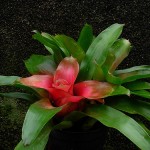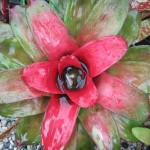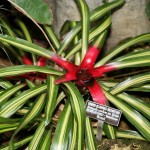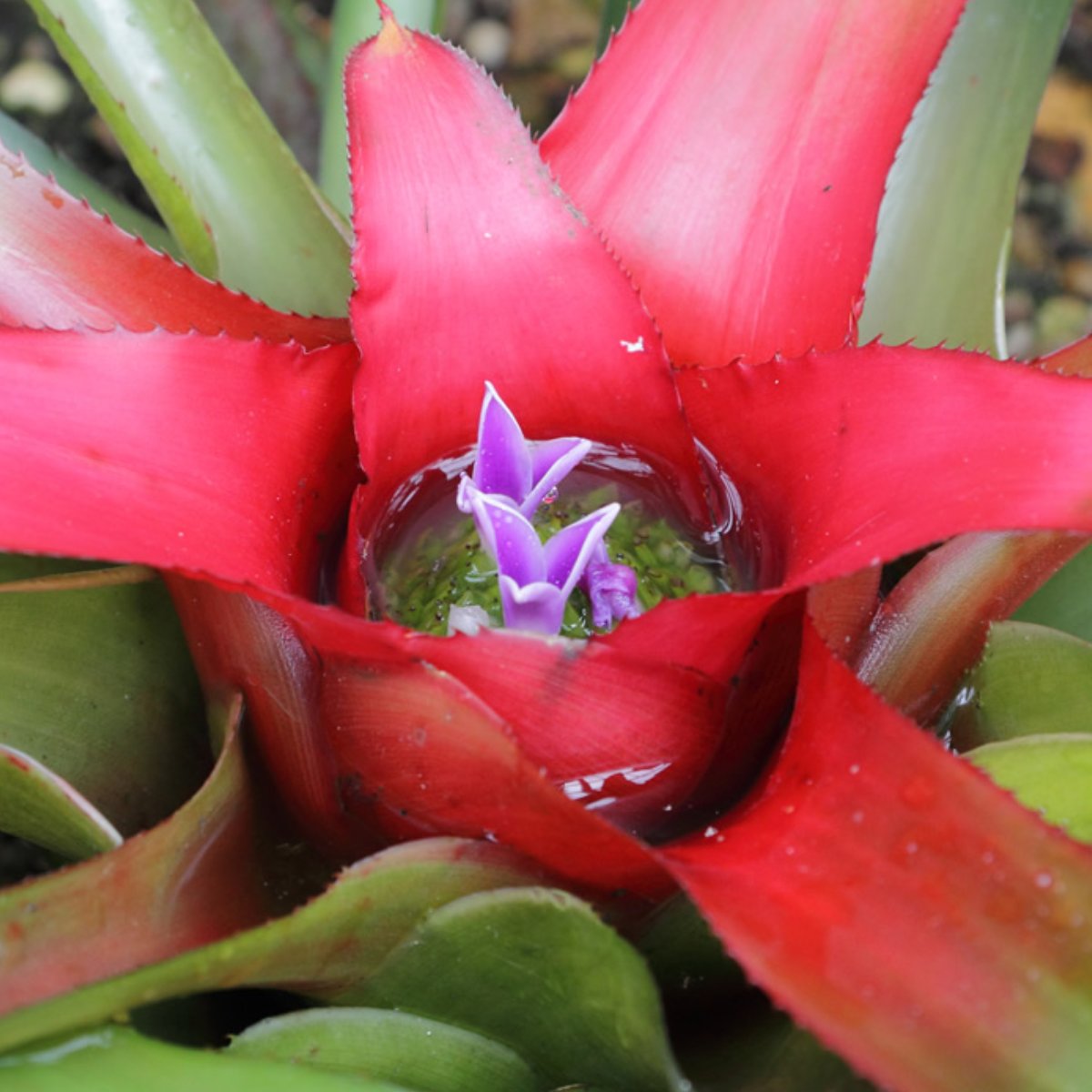Family: Bromeliaceae
Synonymous: Billbergia meyendorffii
Aregelia carolinae
Bromelia carolinae
Regelia meyendorffii
Karatas carolinae
Karatas meyendorffii
Karatas olens
Nidularium meyendorffii
Distribution and habitat: Neoregelia carolinae is a herbaceous monocarpic (it fructifies only once, than dies) evergreen perennial that is native to tropical rain forests in southeastern Brazil. This bromeliad is an epiphyte (grows on other plants, but is not parasitic) that in the wild typically grows soilless.Narrow, leathery, shiny, spine-tipped, lance-shaped leaves form a water holding cup in the centre of the plant where water and decaying debris are collected. The leaves absorb dissolved nutrients from this central cup satisfying the nutritional needs of the plant.
The leaf-vase bursts into glowing colour, effect obviously designed to attract fertilising insect to the tiny flowers, which are almost invisible, barely showing above the water collected and stored in the well of the leaves.
Description: Neoregelia carolinae and its varying forms are rarely more than 22cm (9 inch) tall, with shiny, medium green leaves about 30cm (12 inch) long and about 5cm (2 inch) wide. During the flowering period which can occur at any time of year, there are striking changes of colour in the leaves. The inner leaves of the rosette take on a reddish hue. The remarkable colour remain attractive for several months.When a plant comes into bloom, it usually assumes a flatter shape and the colors intensify. Inflorescence is violet to lavender and appear in the socket centre of the leaf rosette. The clustered flowers held low in the centre of the vase look like a cute miniature water garden. Only a few are open at any given time, but there are many of them and they open over an extensive period of time.
It does not have showy flowers like some members of the bromeliad family: instead it has stunning foliage, with the centre of its vase being brilliant coloured at flowering time and for some months afterwards.
Houseplant care: Neoregelia carolinae can be grown in pots or mounted on wood or cork bark. When mounting a plant, start with a pup not a mature plant.
Neoregelia carolinae adapts to form two different root systems:
- Plants potted in a mix will form a root system that is adapted to taking up water and nutrients from the soil.
- Plants mounted on wood or bark will put out a set of tough strong roots adapted to holding the plant secure, but they will not be able to absorb water and nutrients.
Light: Neoregelia carolinae like bright to almost full sunlight. These bromeliads appreciate some morning or late afternoon sun, but will not tolerate direct mid-day sun in hot summer climates.
They stay more compact and develop more intense color when grown in bright light. These tough leather leafed plants will take the most sun than other bromeliads, but watch them carefully and move them to a lower light location if the leaves start to bleach out.
Temperature: They prefer temperatures in the range from 10 to 32C (50-90F).
High temperatures do not usually harm Neoregelia carolinae, but they do lose some of their bright color. The color will return when the nights begin to get cooler.
These bromeliads grow best with high humidity. Set container on a pebble tray in order to increase humidity.
Water: Potted Neoregelia carolinae should be regularly watered, but not overwatered them. Pour the water through the funnel of leaves rather than directly on the potting mix. Use rain water when is possible.
Stagnant water in the cup is an excellent breading ground for unwanted insects such mosquitoes or bacterias with bad odors. Empty the cup or flush it out with large quantities of water on a weekly basis to avoid disease and insect problems.
Fertiliser: Well established plants growing in good light can be fertilised monthly with a highly diluted general purpose fertiliser during warm weather, but for the most part use very little if any fertilizer to keep good leaf color.
Potting and repotting: Use a soil based potting mixture consisting of equal parts of leaf mould, peat moss and sand. Small plants should be moved to pots one size larger in spring. Neoregelia marmorata, however, are unlikely to require pots bigger than 13cm (5 inch) size.
Propagation: After blooming the mature plant goes into a slow decline, but small plants called pups will develop at the base of plant. When a pup is about half or more the size of the mature plant it can be removed and mounted or it can be potted in its own pot. Pups root quickly in the spring and will usually bloom in 1-3 years. If the pups are not removed, remove the original plant when it dies and allow the pups to grow as a clump.
For those who like adventure, Neoregelia carolinae can be grown from seed, but this is a slow process that can take many years.
Problems:
Rot may develop if soil is kept too moist.
Over fertilisation can lead to over-sized, lanky, green, plants that are more susceptible to insect and disease damage.
Ifbromeliads are crowded and there is little air circulation can develop brown soft bodied scale or the black tea scale infestation.
Treatment: A treatment or two of insecticidal soap will usually bring the brown scale under control.
If abromeliad is infected with black tea scale, it can be destroyed and only an appropriate insecticide will eradicate these insects.
Occasionally these bromeliads will be attacked by a fungal infestation.
Treatment: Recovery from fungal infestation is rapid when treated early with a fungicide.
Use: Neoregelia carolinae is a houseplant for warm and humid areas.
Neoregelia carolinae should be displayed low down where the eye can see into the vivid centre of the plant.
Recommended varieties:
Neoregelia carolinae 'Marechalii' is the most compact variety, has slightly shorter, broader leaves and the centre of the rosette turns carmine-red when the plant is about to flower.
Neoregelia carolinae 'Meyendorffii' has copper-tinged olive green leaves that become dark maroon in the rosette centre at flowering time.
Neoregelia carolinae 'Tricolor' is the most popular variety. It has leaves that are striped in white and rose-pink, as well as green. As this bromeliad matures, the whole leaf becomes suffused with pink and with the approach of flowering time the central leaves of the plant turns brilliant red.
SUMMARY:
CHARACTERISTICS:
Foliage green
Features flowers
Shape rosette
Height: 22cm (9 inch)
Width: 60cm (24 inch)
PROPER CARE:
Watering in active growth period moderately
Light bright
Temperature in active growth period min 10C max 24C (50-75F)
Humidity high
Hardiness zone: 10-11






